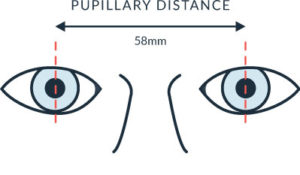
Obviously, this is not ideal Even not in a very small way. Such a shift of the picture can be compensated with an inward or outward rotation of the eyes. When the person wearing the lenses does not look at an object of one meter but let’s say 10 meters these values get multiplied by the distance. When the person wears the lenses and looks at an object that is one meter in front of him this object will be shifted to the side in front of one eye. Every optician is familiar with that formula: P=c*s. In the table below I will give you an idea of how the deviation will influence the vision of the wearer of the glasses.Ī wrong PD can be calculated with the prentice rule. This distance multiplied with the lens power equals the deviation a wrong PD produces. A wrong pupillary distance is measured in millimeters. When the PD is wrong by a millimeter the outcome for the wearer will be very different depending on the lens power in the glasses. When the pupillary distance heavily compromises the way on how the eyes play together the induced change might not come back to the state before the PD was wrong.
PUPIL DISTANCE MOVIE
In most cases, the person still sees perfectly clear but the concentration will suffer as well as the ability to cope with difficult visual tasks like watching a movie in a 3D theater. In addition, this could result not only in discomfort but also in a compromised perception of depth. This constant strain could lead the brain to focus on one eye and switching off the other. What Happens If the PD Is Wrong On Glasses?ĭepending on how far the optical center is decentralized or how wrong the pupillary distance is the person wearing the glasses might feel nothing up to the point where he or she experiences headaches or even double vision. Actually, the markings on the lenses should show the cross right infant of the pupil. Here in the picture above you can see the red lines on the glasses being wider than the pupils. distance between the lower lenses edge and the eye`s pupil.The measurement of the pupillary distance is just one out of a few parameters to describe where to position the optical centers in front of the pupils of the prospect. With a correctly measured pupillary distance, unwanted muscle tension gets reduced to a minimum and the wearer enjoys the best visual comfort.Īs soon as a prescription is built into your glasses the optician needs to decide where to put the optical centers.

Over time, this effort causes visual discomfort and can result in a decreased ability of the eyes to work together in binocular vision. The wearer needs to compensate for a misplaced optical center with increased muscular strain in the eyes.

If those optical centers are misplaced unwanted prismatic effects will be induced, requiring the wearer to turn his eyes inward, or even outward, to keep from experiencing double vision. The Pupillary distance gets measured by opticians to position the optical center of the lenses right in front of the pupils correctly.


 0 kommentar(er)
0 kommentar(er)
